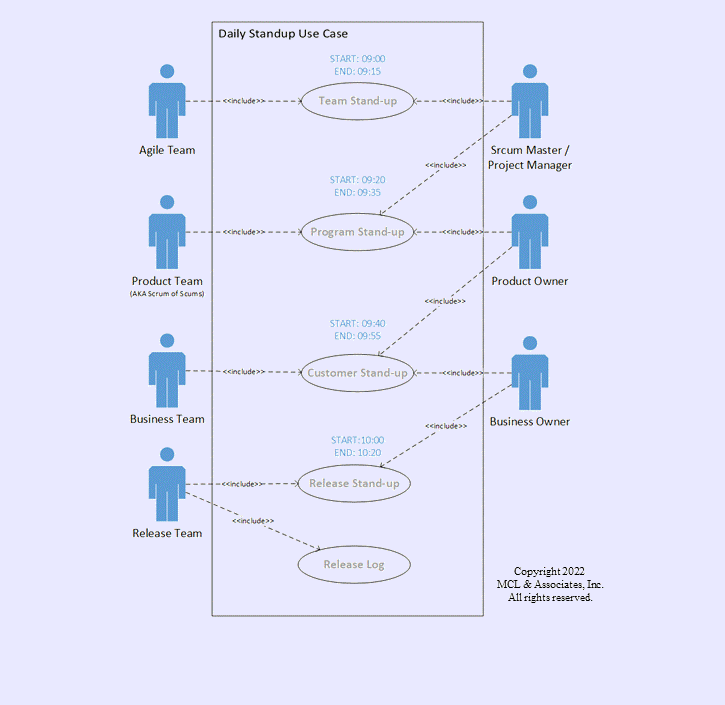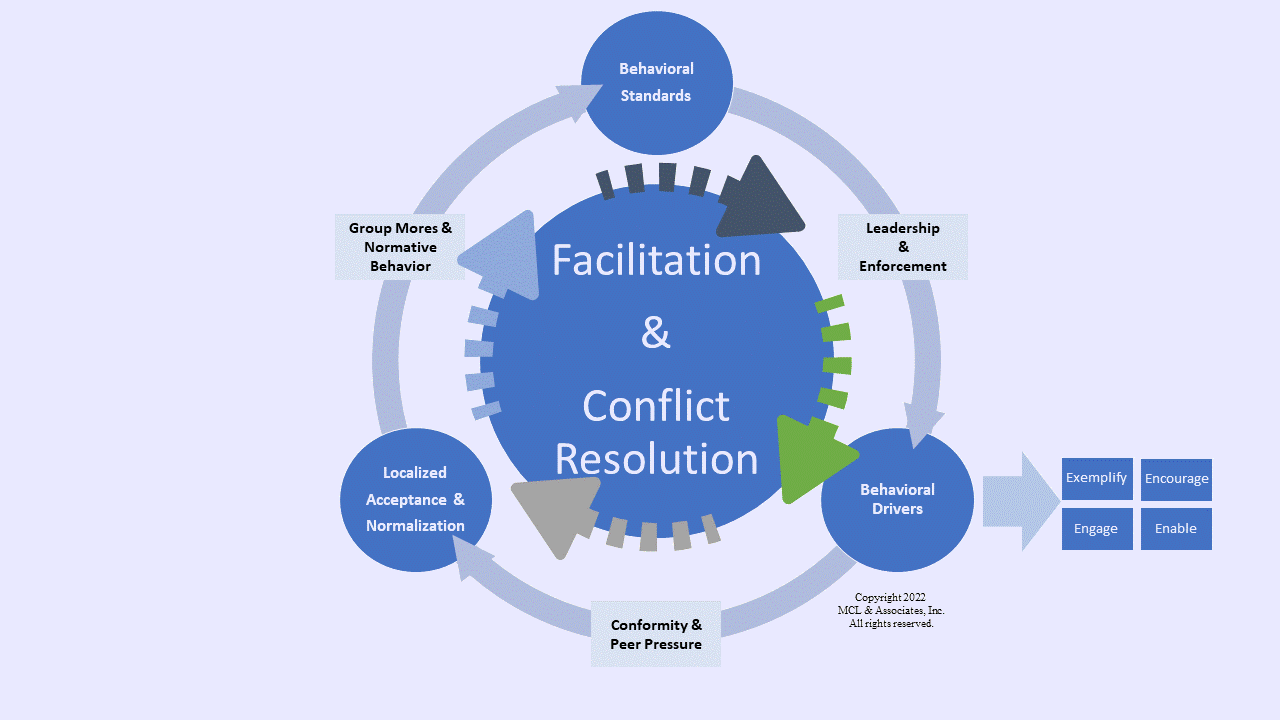07/17/2022:
This multi-part article is the last in a series of five serialized parts that explores why all businesses, all
organizations, and all enterprises should consider daily standups as an integral part of their overall
project and operational communication planning.
Despite the adoption of the Agile framework globally, having a daily standup seems to have been thrown
to the side as a waste of everyone’s time. This article asserts the contrary, that maintaining a disciplined
daily standup regimen is absolutely necessary from a communication and conflict resolution perspective.
It explores eleven common reasons why projects - and by extension, daily operations - fail, and how daily
stand-ups are a necessary first step to achieving overall outcome success.
Eleven Good Reasons for Daily Standups - Part 5
Conflict and Communication
Cultural change, by itself, is neither good nor bad; it is a reaction. It is how humans are hard-wired by the
DNA we share in common. From a sociological perspective, it allows the group to adapt to changes in their
external environment, and to solve new problems that require individual and group action in cooperation and
coordination with others, both internally and externally.
Figure 1: The Cultural Change Process
Initially, cultural change is always an internal challenge to the group’s status quo by an individual, or group of
individuals, within the group. The challenge is in response to some change or condition that demands action
that cannot be satisfied or resolved within the current status quo structure. Whether initiated by formal
leadership or internal thought leaders, the response always leads to conflict and -- if not adequately resolved
-- escalating conflict behavior.
By one means or another, the change that is sought is brought to the attention of a sub-group of the whole. If
received positively, it will be considered, exemplified, encouraged, engaged, and enabled. If negatively
received, it will be ignored, mocked, rejected, or punished. Most attempts to change or modify culture will
result in both positive and negative responses within the group. Invariably, this leads to internal conflicts that
may in turn lead to external conflicts.
It is the conflict generated by cultural change that makes it problematic. In a truly ironic dichotomy of
complementary opposites, humans are equally resistant to change, as well as having the innate ability to
adapt to change. To quote Shakespeare’s “Hamlet”, “there’s the rub”; to adapt to change it is necessary to
initiate internal change at the appropriate interface points. Initiating internal change often creates both
internal and external conflict that demands resolution.
Most managers -- most individuals -- are ill prepared to deal positively with conflict in the work place
because so much of it is covered by employment law and multiple strata of hierarchal authority. Almost any
organizational friction that escalates beyond a “tolerable level” can easily fall under the very large umbrella of
Human Resources. Ultimately, a very complex and expensive process, regardless of outcome.
To resolve these issues before they escalate into something disruptive and dysfunctional, facilitation is
required.
Facilitation is nothing more than a deliberative, cross-communication process guided by a third-party,
preferably a neutral third party; someone who has no stake in the conflict’s eventual outcome, other than a
Win-Win solution for all. Short of that outcome, a negotiated agreement by all parties to take joint action that
will further clarify the options to move forward together. And short of those outcomes, a negotiated
agreement by all parties to refrain from any action that will prevent the parties from moving forward
separately.
Cultural change, and the inevitable generation of interpersonal, role, and resource conflicts that often result,
are always best resolved at the lowest level possible. It is always best to resolve conflicts well before they
become project and operational impediments. Before they become section and departmental food fights.
Before they come to the attention of high-level leadership, and certainly well before they require the
intercession of human resources and legal action. Matters of law are about advocacy and winning. Dispute
resolution and facilitation are all about controlled communication flow, discovering areas of mutual need,
and negotiating an agreement framework where all sides feel that they have gained enough of what they
require to move forward.
This requires more than a one-size fits-all approach. Individuals, the various groups they belong to, their
institutions, and their situations are different, if for no other reason than shifting circumstances and fluctuating
context. Groups within same organization often have very different work cultures and subcultures. What
worked with one group may not work with another. What worked in one situation may not work in one that
appears to be similar.
Fortunately, much of the basic thinking and codification of conflict analysis and dispute resolution techniques
have been crafted and tested over the past half century. It is well past time when these basics models and
techniques be acknowledged as basic every day skill sets that ought to be taught, practiced, and
encouraged as an industry best practice by all.
For an abundance of social and business reasons, we need to finally start the movement away from merely
managing interpersonal and group conflicts, and start the much more efficient and effective task of actually
trying to resolve them.
Why Daily Standups Matter
When everything is said and done, groups and organizations accomplish common goals through
cooperation and communication. Communication can be accurate or inaccurate. Depending on the
circumstances, the roles and responsibilities involved, and the context, any combination of communication,
miscommunication, or lack of adequate communication can often create both internal and external social
conflict. Where, when, and how the conflict presents itself, and the issues and the parties involved, will
determine on how the conflict should be approached.
The phrase “conflict management” has a specific meaning in the lexicon of conflict theory. It refers to
processes that have proven to be efficient and effective in bringing a conflict to a truncated end; where the
details of how and why the conflict has been concluded are often less important than the fact that it has been
curtailed. Within the context of business disputes, a lawsuit is the domestic equivalent of warfare. Walking
away from conflict despite a specific party’s strong feelings of aggrievement is the domestic equivalent of
surrender. Of course, in both cases, the conflict may be “managed” though accommodation, avoidance,
compromise, or tacit collaboration, but in many instances, its underlying causes remain unresolved.
Under such circumstances, a rekindling of the underlying conflict between the parties is likely.
Depending on circumstances, the phrase “external conflict” can have two meanings: either a conflict with
another individual or group within the organization, or a conflict with another individual or group from outside
the organization.
Whether you call it a standup, a daily standup meeting, a daily scrum, a scrum meeting, or even a morning
roll call, the modern purpose of this event is generally the same: to periodically convene a brief meeting at
the beginning of the workday to establish who is available to do work, to review the status of efforts from the
previous day, to review the current day’s activities, and to seek assistance in the removal of any constraints
that impact the timely completion of those tasks.
There has been considerable complaint about daily standups being more dysfunctional than functional.
Complaints abound that it is a waste of time, arguing that its only purpose is to make managers feel the
team members are working hard and under their control, rather than provide actionable insight into how well
the team is progressing against their short-term goal.
I disagree with those assessments. Rather, it suggests a failure to adequately communicate the purpose of
standup meetings to the team, or to its newest members. It is a leadership issue.
If a daily stand up takes more than fifteen minutes to accomplish, either the team is too large, or the incorrect
kinds of information is being shared. As illustrated in Figure 2 -- barring technical difficulties and with a five-
minute cushion to allow managers to get to or to dial into their next higher tier daily standup -- the entire
upward communication path, from the teams to Leadership, can be accomplished within a time duration of
an hour-and-a-half and two hours; with no individual needing to spend more than a half-hour of their time in
the entire daily process.
Figure 2: Daily Standup Use Case
One need only consider the amount time and resources wasted in the various daily combinations of
communication, miscommunication, lack of adequate communication, and unnecessary conflict Daily
standups are a small price to pay for clarity.
The purpose of a daily standup is not task status. Rather it is problem identification, constraint identification,
and the status and initiation of action items and remediation efforts to clear bottlenecks and. Task status can
easily be updated by utilizing a team Kanban. Daily work status and progress updates can be maintained by
updating individual task progress at the end of the workday, available for a quick pre-meeting review by
each successive tier lead.
It is not uncommon for a standup to take far less than the allotted fifteen minutes to accomplish, with
individual reports taking far less than a single minute to complete. This leaves a sizable portion of the
allotted time to focus on the real purpose of the daily standup: workflow issues, shifts in priorities, and the
removal of constraints by managers and leads.
Constraints generally mean that groups of individuals are not, cannot, or will not work together cooperatively.
This leads, inevitably, to conflict.
If there are no issues to discuss, it will be a short meeting. If issues do exist, then collaborative work
meetings can be quickly scheduled to discuss and assign individual action items, trigger communication
flows for information and clarifications, and always to keep in the forefront that projects and operations
ultimately fail because of people, no technology.
Conclusion
So long as humans make decisions about key pathway choices that impact internal and external processes,
communication and the likelihood of escalating human conflict will continue to be relevant to business
operational and project success.
Each of the eleven factors contributing to project failure require efficient and effective daily communication.
Its purpose should be to detect and report any issues or constraints that are preventing tasks or operational
responsibilities from moving forward as planned.
One of the weaknesses of current process improvement theory and implementation is that it completely
ignores the human element; it tends to treat individuals as replaceable parts in a larger machine. This is a
typical managerial, top-down, tunnel-vision perspective that leave line-supervisors and managers -- who
eventually become executives -- completely unprepared to be either efficient managers or effective leaders.
When implemented at all, communication and conflict resolution tend to be mechanical and uninspired.
Communication between individual teams, and collaborative team networks need to be dynamic and
proactive. Short, focused daily standup meetings for all is a necessary first-step toward that end.
References
agilemanifesto.org_1. (2001, Feb). History: The Agile Manifesto. Retrieved from agilemanifesto.org:
http://agilemanifesto.org/history.html
agilemanifesto.org_2. (2001, Feb). Manifesto for Agile Software Development. Retrieved from
agilemanifesto.org: https://agilemanifesto.org/
Axelrod, A. (2008). Bradley: A Biography. Hounmills, Basingstroke, Hampshire UK: Palgrave MacMillan.
Beck, K. (1999). Extreme Programming Explained: Embrace Change. Reading, MA: Addison Wesley
Longman, Inc.
Burton, J. W. (1969). Conflict & Communication: The Use of Controlled Communication in International
Relations. New York: The Free Press.
Clark, T. R. (2022, Feb 21). Agile Doesn’t Work Without Psychological Safety. Retrieved from Harvard
Business Review: https://hbr.org/2022/02/agile-doesnt-work-without-psychological-safety?ab=hero-subleft-1
Fischer, R., & Ury, W. (1991). Getting to Yes: Negotiating Agreement Without Giving In; Second Edition.
New York, NY: Penguin.
Forsgren, N., Humble, J., & Kim, G. (2018). Accelerate: The Science of Lean Software and DevOps:
Building and Scaling High Performing Technology Organizations. Portland, OR: IT Revolution.
Hansson, H. (2020, FEB 14). Purpose of Meetings. Retrieved from dockethq.com:
https://www.dockethq.com/resources/purpose-of-meetings/
Kaplan, F. (2016). Dark Territory: The Secret History of Cyber War. New York, NY: Simon & Schuster.
Masli, A., Richardson, V. J., Weidenmier Watson, M., & Zmud, R. W. (September 2016). Senior Executives’
It Management Responsibilities: Serious It-Related Deficiencies and CEO/CFO Turnover. MIS Quarterly ,
September 2016, Vol. 40, No. 3, 687-708.
MCL & Associates. (2022, 03 17). PEOPLE: What the heck do we do with them? Retrieved from MCL &
Associates, Inc., Small Business Transition Blog: https://www.mcl-associates.com/People-
what_the_heck_do_we_do_with_them.html
Opendoor Technology. (2021, Nov 25). The Standish Group Reports 83.9% of IT Projects Fail - How to
Save Yours. Retrieved from opendoorep.com: https://www.opendoorerp.com/the-standish-group-report-83-
9-of-it-projects-partially-or-completely-fail/
Porter, J., & Baker, E. L. (2006). Meetings, Meetings, and More Meetings. Journal of Public Health
Management and Practice (Vol. 12, No. 1 (January-February), 103 - 106.
Powell, C. L. (2003, Oct 28). Why Leadership Matters in the Department of State. Retrieved from
GovLeaders.org: https://govleaders.org/powell-speech.htm
RingCentral, Inc. (2022, MAR 27). Meet with a Purpose: 5 Types of Meetings. Retrieved from
ringcentral.com: https://www.ringcentral.com/guide-to-better-meetings/types-of-meetings
Second Rise LLC. (2022, MAR 27). https://www.lucidmeetings.com/meeting-types. Retrieved from
lucidmeetings.com: https://www.lucidmeetings.com/meeting-types
© Mark Lefcowitz 2001 - 2024
All Rights Reserved









